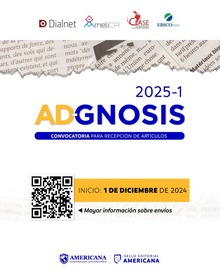Network analysis and agent-based modeling of micro-businesses
DOI:
https://doi.org/10.21803/adgnosis.13.13.606Keywords:
Small business, Financing, Consumption, Private company, Public company, Simulation modelAbstract
Introduction: The analysis of the structures of social networks and agent-based simulation models allow to know and analyze the behavior of the different actors interacting within a system. Objective: To conduct a network analysis and agentbased modeling of microbusinesses to understand, identify and compare the existing relationships and behavior among actors, suppliers, creditors, public and private institutions of
microbusinesses in the grocery industry in the central district of Honduras through a simulation model. Methodology: This local study was carried out with a descriptive nature, under a mixed approach where data were collected through interviews with managers of the The data were collected through interviews with managers of micro-businesses that represent the entire
population of the study unit. Results: Pajek software was used for the elaboration of the network systems and NetLogo was used for the development of the simulation model. Conclusions: The centrality and density of the actors in a network, together with the modeling through simulation, allows us to know the
approximations and behavior of the agents that approaches and behavior of the agents that guarantee the sustainability and productivity of micro-businesses.
Downloads
References
Aguirre, J. L. (2011). Introducción al análisis de redes sociales (Vol. 82). https://www.ciepp.org.ar/images/ciepp/docstrabajo/doc%2082.pdf
Ávila-Toscano, J. H. (2012). Redes sociales y análisis de redes. Aplicaciones en el contexto comunitario y virtual. Barranquilla: Corporación Universitaria Reformada. https://dialnet.unirioja.es/servlet/libro?codigo=511130
Barahona Alonzo, J. M. (2017). Las incubadoras de empresas como medio de éxito, emprendimiento y desarrollo sostenible de las MIPYMES industriales del Distrito Central [Universidad Nacional Autónoma de Honduras]. http://www.tzibalnaah.unah.edu.hn/handle/123456789/7589
Banco Central de Honduras. (2022). Informe de Gestión y de Resultados (IV TRIMESTRE). https://www.bch.hn/acerca-del-bch/planeamiento-estrategico/informe-de-gestion-y-resultados-de-poa-y-ejecucion-presupuestaria
Citarella ESPINOZA, M. ., & Insignares Blanco, E. (2021). La auditoría financiera y su proyección en la rentabilidad de las empresas. Ad-Gnosis, 10(10), 141-149. https://doi.org/10.21803/adgnosis.10.10.475
Espinosa Atoche, T. D. J., Uc Heredia, L. J., & Maldonado Guzmán, G. (2018). Los ingresos familiares como una fuente de financiamiento de los micronegocios de mujeres de la península de Yucatán, México. Tec Empresarial, 12(1), 31–38. https://doi.org/10.18845/te.v12i1.3569
Fernández Fernández, P., & Díaz Varela, E. R. (2018). DESARROLLO DE PROTOCOLO Y MÉTRICAS DE ANÁLISIS DE INTERESADOS EMPLEANDO LA PERSPECTIVA DE ANÁLISIS DE REDES SOCIALES (ARS). http://dspace.aeipro.com/xmlui/bitstream/handle/123456789/1556/AT01-003_2018.pdf?sequence=1&isAllowed=y
Fullana Belda, C., & Urquía Grande, E. (2009). Los modelos de simulación: Una herramienta multidisciplinar de investigación. Encuentros multidisciplinares https://dialnet.unirioja.es/servlet/articulo?codigo=3023238.
González Campo, C. H. (2007). Sistemas, modelos y decisiones. El impacto de la simulación en la administración de organizaciones complejas. Cuadernos de Administración, 36–37, 294–316, https://www.redalyc.org/articulo.oa?id=225020349010.
González Samaniego, A. (2006). Los micronegocios detallistas familiares del ramo de abarrotes en la región de Apatzingán [Universidad Michoacana de San Nicolás de Hidalgo]. http://bibliotecavirtual.dgb.umich.mx:8083/xmlui/handle/DGB_UMICH/5818
Guatzozón Maldonado, M., Canto Esquivel, A. M., & Pereyra Chan, A. (2020). Calidad en el servicio en micronegocios del sector artesanal de madera en una comisaría de Mérida, México. Ingeniare. Revista Chilena de Ingeniería, 28(1), 120–132. https://doi.org/10.4067/S0718-33052020000100120
Hanneman, R. A., & Riddle, M. (2005). Introduction to social network methods. University of California Riverside. https://wiki.gonzaga.edu/dpls707/images/6/6e/Introduction_to_Social_Network_Methods.pdf
Izquierdo, L. R., Galán, J. M., Santos, J. I., & Del Olmo, R. (2008). Modelado de sistemas complejos mediante simulación basada en agentes y mediante dinámica de sistemas. EMPIRIA. Revista de Metodología de las Ciencias Sociales, 16, 85–112. https://www.redalyc.org/articulo.oa?id=297124024004.
Kuz, A., Falco, M., & Giandini, R. (2016). Social Network Analysis: A Practical Case Study. Computación y Sistemas, 20(1). https://doi.org/10.13053/cys-20-1-2321
Leskovec, J., & Faloutsos, C. (2006). Sampling from large graphs. Proceedings of the 12th ACM SIGKDD International Conference on Knowledge Discovery and Data Mining, 631–636. https://doi.org/10.1145/1150402.1150479
Navarro Sánchez, L. A., & Salazar Fernández, J. P. (2007). Análisis de redes sociales aplicado a redes de investigación en ciencia y tecnología. Síntesis Tecnológica, 3(2), 69–86. https://doi.org/10.4206/sint.tecnol.2007.v3n2-03
Ojeda, S. G., Moreno, L. D., & Retamal, I. G. (2017). Modelación y simulación simultánea de un fenómeno. Elementos precursores de lo bilineal. Paradigma, 38(2), 308–333 https://www.revistas-historico.upel.edu.ve/index.php/paradigma/article/view/6375.
Rousse, R., Villegas, J. C., & Lárez, C. (2011). Uso de NetLogo como un entorno multiagente para el desarrollo de modelos de polielectrolitos. Ciencia e Ingeniería, 32(2), 127–133. https://www.redalyc.org/articulo.oa?id=507550794014.
Rodríguez, R. ., Landazury Villalba, L. F., Lugo Arias, E. R. ., Sandoval Reyes, R. ., & Jiménez Celín, Y. P. . (2020). Descripción de la situación actual del sistema logístico en la región caribe colombiana. Ad-Gnosis, 9(9), 83–95. https://doi.org/10.21803/adgnosis.9.9.439
Rúa, A. de F. de la. (2008). Análisis de redes y trabajo sociales. Portularia, VIII(1), 9–21. Redalyc.
Sanz Menéndez, L. (2003). Análisis de redes sociales: O cómo representar las estructuras sociales subyacentes. https://digital.csic.es/handle/10261/1569
Schucry Kafie (2018, 14 junio). ¿Es Honduras un país apto para el emprendimiento y los negocios? https://schucrykafie.com/es-honduras-un-pais-apto-para-el-emprendimiento-y-los-negocios
Sosa Valdés, R. (2014). El financiamiento de los micronegocios en México [Universidad Autónoma de Nuevo León]. http://eprints.uanl.mx/4101/1/ROBERTO%20SOSA%20VALD%C3%89S.pdf
Vélez Torres, Á. (2019). Modelación y simulación basada en agentes en ciencias sociales: Una aproximación al estado del arte. Polis (Santiago), 18(53). https://doi.org/10.32735/S0718-6568/2019-N53-1392
Wilensky, U., & Reisman, K. (2006). Thinking Like a Wolf, a Sheep, or a Firefly: Learning Biology Through Constructing and Testing Computational Theories—An Embodied Modeling Approach. Cognition and Instruction, 24(2), 171–209. https://doi.org/10.1207/s1532690xci2402_1
Zambrano-Vargas, S. M., & Vázquez-García, A. W. (2019). Algunas perspectivas teóricas para el estudio del emprendimiento y el género. Saber, Ciencia y Libertad, 14(1), 159–170. https://doi.org/10.18041/2382-3240/saber.2019v14n1.5216

Downloads
Published
Issue
Section
License
Copyright (c) 2024 AD-GNOSIS

This work is licensed under a Creative Commons Attribution-NonCommercial-NoDerivatives 4.0 International License.





